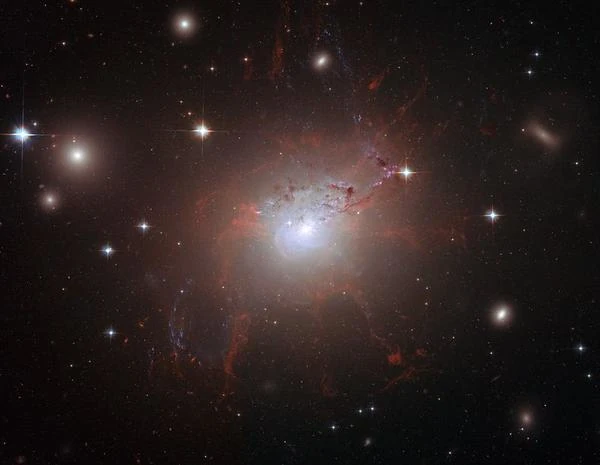
NGC 1275 is an active galaxy located at the center of the Perseus Cluster. It stands out for its complex structure and interactions with the intergalactic medium, producing extended gaseous filaments and relativistic jets. This galaxy is a unique laboratory for studying the processes of galaxy formation and evolution in a dense environment.
NGC 1275 has an irregular morphology with numerous ionized filaments and star-forming regions. Its active nucleus powers plasma jets detectable in radio and X-ray. The speed of these jets can reach a significant fraction of the speed of light, indicating relativistic phenomena.
The filaments observed around NGC 1275 consist of ionized gas extending over tens of thousands of light-years. These structures are likely the result of the interaction between the relativistic jet and the intra-cluster gas.
The active nucleus of NGC 1275 powers jets of matter that sculpt the surrounding gas. Radio and X-ray observations show plasma bubbles and synchrotron emission regions, evidence of particle acceleration to high energies.
NGC 1275 has been observed since the 19th century and was classified as a Seyfert galaxy in the 20th century. Recent studies combine multi-wavelength observations and numerical modeling to understand the interactions between the jet and the intra-cluster gas.
N.B. :
The relativistic jets of NGC 1275 provide a concrete example of the phenomena predicted by Albert Einstein's (1879-1955) special relativity.
| Characteristic | Value | Observation | Comment |
|---|---|---|---|
| Distance | ≈ 240 Mpc | Redshift measurements | Corresponds to z ≈ 0.0176 |
| Core Mass | ≈ 8 × 108 M☉ | Dynamic modeling | Supermassive core responsible for jets |
| Galaxy Type | Seyfert 1.5 / Irregular | Morphological classification | Turbulent central galaxy of the cluster |
| Jets | ≈ 0.3c | Radio/X-ray observation | Plasma accelerated to relativistic speed |
| Filaments | ± 50 kpc | Optical and Hα imaging | Extended ionized gas around the core |
Sources: NASA/IPAC Extragalactic Database, Hubble Space Telescope observations.
NGC 1275 is a fascinating example of a central cluster galaxy, where turbulence, relativistic jets, and gas filaments interact.